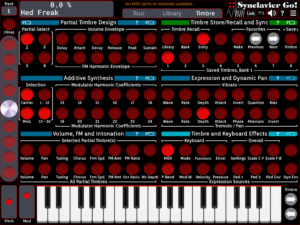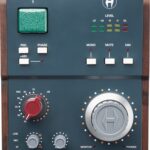The Synclavier enjoys a status as one of the first synthesizer computer workstations; appearing on too many popular 80s releases to mention. The price for this digital behemoth ran anywhere from $25,000 to $200,000, depending on the configuration. Frank Zappa, Trevor Horn, Eddie Jobson, Tony Banks and so many others used the Synclavier as a major part of their work from that time.
Eventually, the synth became obsolete and production ended in the early 90s, with manufacturer New England Digital closing shop. As an aside, I sent NED my résumé upon graduating from college a few years before their 1993 demise. Sadly, I never heard back.
Ultimately, so many features now commonplace in music technology – hard disk recording, sampling, FM and additive synthesis, and much more – first became practical with the Synclavier. So imagine fitting all that power and functionality into an iOS app? Enter Synclavier Go!
Synclavier Go! for iOS Features
- Emulation of the Synclavier II for the iPad
- Original CSynclavier DSP Engine Supports Partial Timbre, Timbre Frame, FM Synthesis and Additive Synthesis
- Useful Embedded Tutorial
- Timbre Library Includes Over 900 Sounds – Some of Them Very Famous
- 16-Track Multi-timbral Sound
- Control Over Bit Depth and Noise Floor
- Support for Audiobus, Bluetooth MIDI, and Ableton Link
- Available at the App Store for $29.99
Synclavier Go! is a worthy acquisition for any iOS musician simply because of its historical importance. The sound quality is great; not surprising since the app was developed by Cameron Jones, the software engineer for the original. Diving into its rich timbre library reveals many classic 80s tones, but others also stand out in a more modern context.
Let’s dive a bit deeper into this excellent re-imagination of one of the most important synthesizers in music history.
The Massive Synclavier User Interface on the iPad
The Synclavier Go! user interface simulates the original as well as can be expected on the iPad. Essentially you edit one or more parameters using a virtual “uber” knob that works just like the original. There is an even a hardware version of the knob available for $399 for those who want a true tactile experience.
A massive number of red buttons are used to select parameters, once again similar to the original. This seems daunting at first, but becomes rewarding after spending significant time with the app. Selecting multiple buttons in one fell finger swipe is simple.
These parameters are grouped in sections, covering the different parts of the Synclavier’s synth architecture. They include FM Synthesis, Additive Synthesis, Timbre and Keyboard Effects, Partial Timbre Design, and more. Another section is used to save and load Timbres.
Many original users simply trusted their ears when programming timbres, as opposed to getting bogged-down in parameter value minutiae. The detailed tutorial embedded within Synclavier Go! provides context when needed. Exploration and empirical analysis remain the key to creating your own timbres.
Beyond that, the interface makes browsing through the timbre library a breeze, with it accessible at the top of the screen, along with other utility functions. Needless to say, Synclavier Go! successfully shrinks the massive UI of the original into the iPad’s footprint. If the complexity of the Synclavier’s synth engine seems daunting, simply select a few red buttons and tweak that big knob. Undoubtedly, the cool sounds will find YOU.
That Classic 80s Synclavier Synthesizer Sound
After perusing through a variety of Synclavier timbres from those classic days of yore, there’s no doubt this iPad app provides an accurate representation of their sound. Remember, the app contains the exact same DSP code as the original machine. Reading through its history, the original designers, including Cameron Jones, wanted the synth to sound analog. Manipulating my own sounds in real time reveals this iOS app hits the mark.
Complex sounds are possible, as each timbre contains up to 12 partial timbres. Each partial sports two oscillators and envelopes, and 24 harmonics. The latter is important as additive synthesis resides at the heart of the Synclavier. FM synthesis comes into play with an FM amount and carrier ratio parameters for each oscillator pair. An unlimited number of frames add an element of motion to each sound.
The app also supports the original’s robust microtuning engine. If this area of synthesis interests you, Synclavier Go! provides an implementation rivaling nearly all other software synthesizers. It’s another aspect of a synth design that rewards those making a deeper dive into its more esoteric functionality.
This iPad Synclavier also supports other modern iOS musician features, like Audiobus, Ableton Link, and Bluetooth MIDI. Check out the free Synclavier Pocket! – also available for the iPhone – to get a better idea of its sound and programming horsepower. It only provides 4 partials per timbre and you need to buy a $4.99 in-app purchase to save your work, but it’s a great way to try before you buy.
At a price of $29.99, Synclavier Go! ranks among the most expensive iOS synth apps at the App Store. Nonetheless, when considering it’s arguably the best FM and additive synth currently available on the platform, recommending the purchase becomes easy. Adding the historical relevance of the synth and its seminal timbre library to the equation simply makes it a no-brainer.
As mentioned in our coverage of NAMM 2019, I considered picking up a Korg Volca Modular or a Volca FM, and decided not to after playing around with Synclavier Go! So there!


How much was this originally? I’ll take a stab $100,000?
As noted in the article, the Synclavier’s price varied from around $25,000 to $200,000 depending on the feature set.